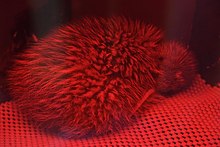Okarito kiwi
| Okarito kiwi | |
|---|---|

| |
| An Okarito kiwi chick | |
| Scientific classification | |
| Kingdom: | |
| Phylum: | |
| Class: | |
| Order: | |
| Family: | |
| Genus: | |
| Species: | A. rowi
|
| Binomial name | |
| Apteryx rowi Tennyson et al., 2003
| |
The Okarito kiwi (Apteryx rowi) also known as the rowi or Okarito brown kiwi, is a member of the kiwi family Apterygidae, described as new to science in 2003. The species is part of the brown kiwi complex, and is morphologically very similar to other members of that complex. It is found in a restricted area of the Okarito forest on the West Coast of New Zealand's South Island,[1] and has a population of about only 400 birds.[2] Some Okarito brown kiwis may live up to 100 years.[3]
Taxonomy
The Okarito kiwi is a monotypic species.[1] Their genus name Apteryx stems from the Greek "without wings".[4] This bird is a ratite and has similarities to the others (emu, ostrich, rhea, cassowary). Its sternum has no keel, its wings are minimal, and it has no preen gland. Its palate is also distinctive, and its feathers have no barbules or aftershaft. Other features that are similar to only the other kiwis is a weak gizzard and no tail, only a pygostyle.[5]
Range and habitat
The Okarito brown kiwi lives in the Okarito forest on the West Coast of New Zealand's South Island.[1][2] On 29 June 2010, three breeding pairs were released onto Blumine Island as part of a breeding program.[6]
Reproduction
The female can lay up to three eggs, each in a different nest. Both the male and the female incubate the eggs. The egg is very large, as it weighs 20% of the female's weight (as in all kiwis). Most pairs are monogamous throughout their lives.[3]
Status and conservation
Its conservation status has been set as "nationally critical". Conservation efforts such as Operation Nest Egg and the stoat control regime have been partially successful in restoring the rowi population. However, the rowi is still in a fragile stage of existence. Predation, mainly from imported animals such as stoats, is still the biggest threat to the rowi. The South Okarito Forest was designated a kiwi sanctuary in 2000.[3]
The West Coast Wildlife Centre in Franz Josef village operates a conservation programme as part of Operation Nest Egg. Eggs at risk of predation are removed, the chicks hatched in captivity, raised in a natural predator-free environment until old enough to fend for themselves, and then returned to the wild. Since opening, the operation has successfully raised and released 180 kiwi chicks. Surveys have ensured that there is no noticeable difference in behaviour between such birds and rowi growing up fully in the wild.[7] The centre was developed in 2010 and offers behind the scenes tours of its kiwi hatching and rearing facilities and is the only place in New Zealand where one can see rowi in a nocturnal walkthrough area.[8]
Footnotes
- ^ a b c Clements, J (2007)
- ^ a b New Zealand Department of Conservation (DOC), (2009)
- ^ a b c New Zealand Department of Conservation (D.O.C), (2009(a))
- ^ Gotch, A. F. (1995)
- ^ Davies, S. J. J. F. (2003)
- ^ "Kiwi released on Blumine Island". The Marlborough Express. 30 June 2010. Retrieved 1 November 2011.
- ^ First-hand information from West Coast Wildlife Centre "Behind the Scenes" tour, see also West Coast Wildlife Centre Backstage Pass
- ^ Anna Turner (20 Jul 2012). "Influx of kiwi eggs forces centre expansion". The Press. Retrieved 2015-03-19.
References
- Clements, James (2007). The Clements Checklist of the Birds of the World (6 ed.). Ithaca, NY: Cornell University Press. ISBN 978-0-8014-4501-9.
- Davies, S.J.J.F. (2003). "Kiwis". In Hutchins, Michael (ed.). Grzimek's Animal Life Encyclopedia. 8. Vol. Birds I Tinamous and Ratites to Hoatzins (2 ed.). Farmington Hills, MI: Gale Group. pp. 89–90. ISBN 0-7876-5784-0.
- Gotch, A.F. (1995) [1979]. "Kiwis". Latin Names Explained. A Guide to the Scientific Classifications of Reptiles, Birds & Mammals. London: Facts on File. p. 180. ISBN 0-8160-3377-3.
- New Zealand Department of Conservation (DOC) (2013). "Rowi: New Zealand native land birds". New Zealand Department of Conservation (DOC). Retrieved 2013-11-28.
- Tennyson, A.J.D.; Palma, R.L.; Robertson, H.A.; Worthy, T.H.; Gill, B.J. (2003). "A new species of kiwi (Aves, Apterygiformes) from Okarito, New Zealand". Records of the Auckland Museum. 40: 55–64.

